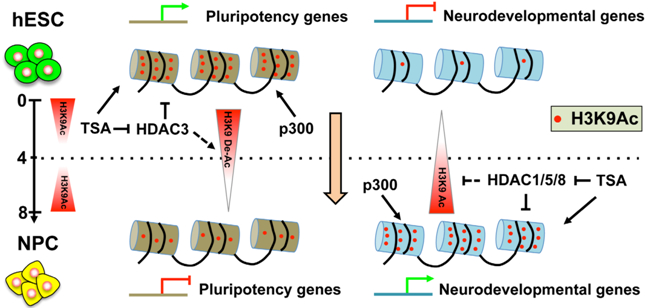
Histone H3 lysine 9 acetylation (H3K9Ac) is an epigenetic mark representing transcriptionally active chromatin involved in various processes. However, it remains unclear how H3K9Ac participates in human neural development and neural fate determination.
Dr. JING Naihe's group at Institute of Biochemistry and Cell Biology, Shanghai Institutes for Biological Sciences of Chinese Academy of Sciences reported the dual roles of H3K9Ac in pluripotency maintenance and neural determination.
Human embryonic stem cell (hESC) neural differentiation in vitro was used as a model system to investigate the epigenetic mechanisms underlying human neurodevelopment. The researchers found that H3K9Ac gradually declines during pluripotency lost (1st stage) and then increases during neural fate acquisition (2nd stage). Inhibiting H3K9 deacetylation by histone deacetylase inhibitors (HDACi) at 1st stage promoted hESC pluripotency and suppressed its neural differentiation. HDACi treatment at 2nd stage enhanced neural differentiation and activated multiple neurodevelopmental genes.
ChIP-seq analysis revealed that the H3K9Ac enrichment at several pluripotency genes was decreased, and H3K9Ac occupancies at the loci of neurodevelopmental genes increased during hESC neural commitment. The function of histone deacetylase (HDAC) members was studied separately. HDAC3 and HDAC1/5/8 were identified to participate in different processes during hESC neural differentiation by interfering with gene-specific histone acetylation patterns. The results suggest that H3K9Ac plays dual roles in hESC pluripotency maintenance and neural differentiation.
This study entitled “Dual Roles of Histone H3 Lysine 9 Acetylation in Human Embryonic Stem Cell Pluripotency and Neural Differentiation” was published in The Journal of Biological Chemistry.
This work was funded by the "Strategic Priority Research Program" of the Chinese Academy of Sciences, National Key Basic Research and Development Program of China, and the National Natural Science Foundation of China.

Figure: Model for H3K9Ac functions in hESC pluripotency maintenance and neural commitment. (Image by Prof. JING Naihe`s group)

86-10-68597521 (day)
86-10-68597289 (night)

86-10-68511095 (day)
86-10-68512458 (night)

cas_en@cas.cn

52 Sanlihe Rd., Xicheng District,
Beijing, China (100864)

